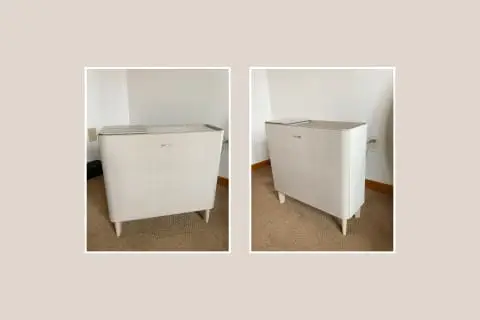
January 7, 2023
Our editors have independently chosen the products listed on this page. If you purchase something mentioned in this article, we may
As someone who has moved apartments over 10 times in her adult life, I think long and hard before adding any new appliances or devices to my home. I fully believe that how cluttered or well-kept my living space is plays a huge role in my overall health and well-being. So when I began researching air purifiers for dust, mold, and allergies, I was struck by the idea that my home might not be as clean as meets the eye.
Determined to ensure I was breathing healthy air, but not willing to sacrifice my thoughtful home design, I set out to find an air purifier that would add to the aesthetic. The first option to catch my eye? The Coway Airmega IconS. Below, learn my honest thoughts on the device and what I’ve learned about air quality and air purification.
Advertisement
This ad is displayed using third party content and we do not control its accessibility features.

Why does indoor air quality matter?
Research backs that the air indoors tends to be significantly more polluted than outdoors1. And while many of us wish we could alleviate air quality concerns by simply spending more time out in nature, the reality is that most of our lives require an extensive amount of time spent indoors.
In fact, those household chores are oftentimes what pollutes the air in the first place. Think: burning your favorite candle, cooking a new recipe, or even using conventional cleaning products. Each of these seemingly harmless activities can negatively affect the air in your living space. Dust and other small particles can be harmful to your respiratory health2, worsening symptoms (like sneezing and wheezing) or conditions such as asthma.
Of course, pollutants can enter your home from outside3, too. Additionally, many homes have more airborne mold than you might think, which can cause brain fog4, anxiety, and chronic fatigue5.
Advertisement
This ad is displayed using third party content and we do not control its accessibility features.
We’ve talked with experts at length about how an air purifier can impact your health. In terms of who might want to consider an air purifier, Shelly Miller, Ph.D., previously told mindbodygreen it could be a good choice if you live in a highly polluted city, your home is exposed to traffic-related air pollution regularly, your area is prone to wildfires, or you have a sensitive respiratory system or condition such as asthma.
Mold is another reason to invest in an air purifiers: “Mold spores are usually under 40 microns in size, so air purifiers with HEPA filters can usually filter out airborne mold spores,” allergist Anjuli Mehrotra, M.D., previously told mindbodygreen. Just remember that you need to replace our filters regularly to ensure those captured spores don’t bloom.
Advertisement
This ad is displayed using third party content and we do not control its accessibility features.
Why I chose the Airmega IconS.
I previously had my eye on another model from the same brand, the Coway Airmega AP-1512HH, which we’ve included in our roundups for the best air purifiers for mold and the best air purifiers for allergies. While a standout design for sure, I was after something that covered a bit more ground. For reference, the AP-1512HH only covers up to 361 square feet, while the Airmega IconS can tackle up to 649 square feet (otherwise known as the size of my living space and kitchen area). Knowing I didn’t want to invest in multiple purifiers for the same room, I decided to splurge on the larger model.
A few things I’d change.
Before I wax poetic about the things I love about my new air-cleaning device, let’s cover a few things I would change if I could. I was at first intrigued by the fact that this sleek purifier connects to WiFi, with a corresponding app for adjustments from afar. Unfortunately, the app has proven to be less-than-ideal—so much so that I don’t even use it. With glitches that made me struggle to even create an account, it simply doesn’t provide a great user experience.
The app is certainly not required to properly operate your purifier, but it does (allegedly) have some great features, such as timer settings, customized scheduling, outdoor air quality readings, and viewings of how your indoor air quality has changed overtime. Current air quality can be monitored on the device’s touchscreen, which is what you will use to switch between modes, should you choose not to use the app.
While the size of the device does not bother me, those who live in small spaces might find it a bit large (and may be better off with something more compact like the previously mentioned Airmega AP-1512HH).

What I love about the Airmega IconS.
We’ve covered that I love the design: It’s sleek and unsuspecting with a beige exterior that blend in with any surrounding decor. What’s more, the extremely convenient touchscreen turns off automatically after 30 seconds, as opposed to other appliances with glaring lights that might interfere with your sleep or aesthetic.
One albeit unnecessary but greatly appreciated feature is the built-in wireless charging station on top. Simply place a compatible device on top and it will charge right up.
I enjoy the optional glowing light that indicates how clean your air is (measuring the current concentration of PM2.5 particles), showing blue for good quality (0-15), green when moderate (16-35), yellow when unhealthy (36-75), and red when very unhealthy (76 or higher). When I first plugged mine in, it indicated that my air was unhealthy (42)—and I was quite impressed by the speed at which the device cleared the air. It took less than 10 minutes to bring it down to 1.
For reference, PM2.5 measurement tells you the amount of matter in the air measuring 2.5 micrometers or less in diameter. We’ll note, there are other models (from this brand included) that offer additional air quality readings, such as PM10 (particles as small as 10 microns), VOC, CO, and CO2. Others even measure humidity and temperature. If those details are important to you, or you’re looking for something a bit less expensive, you might consider another device, such as those listed below.
Effective & affordable alternatives
How the Coway Airmega IconS works.
The Airmega IconS uses a dual-filter system. First, the pre-filter catches larger particles such as dust and hair. Next the brand’s Max2 filter includes a HEPA filter, which, per our expert, eliminates 99.9% of ultra-fine contaminants, and an activated carbon filter to remove odors and volatile organic compounds (VOCs). According to the brand, the device removed dust mites, pollen, bacteria, odors, mold, viruses, and more unwanted pollutants, A light on the purifier’s screen will indicate when the filters need to be replaced, often every year or so.
The control screen is also incredibly easy to use; it allows you to switch between the device’s three modes: smart, sleep, or eco—or manually selet from three purifier speeds. In smart mode, the purifier automatically switches between levels depending on how clean the air is. Eco mode turns the machine off automatically for up to 30 minutes, when the air quality is good. Most appreciated, sleep mode actually detects darkness in the room and powers the device down to level one to minimize noise (and save power) while you sleep.

The takeaway.
I may have initially been drawn in by the visual design of the Airmega IconS, but I’ve been equally impressed by the device’s ability to quickly (and fairly quietly) clean my air. I spend a great deal of time at home: working, exercising, and, well, living. Now, I can breathe easier knowing that my air quality is healthy. Next I plan to tackle my issue of dry air (and equally dry skin!)—perhaps with one of these desktop humidifiers.
Advertisement
This ad is displayed using third party content and we do not control its accessibility features.









